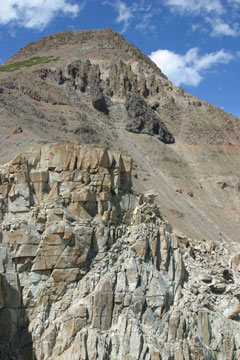|
NEWS NOTES
Plate Tectonics
Birthing the Sierra Nevada
 Keith Putirka |
| Based on the age of a layer of potassium-rich rocks, researchers looking into the timing of the uplift of the Sierra Nevada have created a new model for how and when the mountains grew — and the new model suggests the mountains rose 6 million to 7 million years earlier than previously thought. |
For years, researchers have wondered exactly when and how the Sierra Nevada rose. Now they have a better idea.
Millions of years ago, the Sierra Nevada lost the root that anchored the mountains deep inside Earth. During this process — called lithosphere delamination — the upper part of Earth’s mantle deep beneath the Sierra Nevada peeled off from the overlying crust, letting parts of the hot mantle flow in to fill the void. This buoyant material may have lifted the mountain range. “You could compare the Sierra Nevada to a block of wood floating in water and the lithosphere to an iron layer glued to its base,” says Keith Putirka of California State University at Fresno. “Once you remove the iron the wood will float higher.” Some scientists have placed this event at about 3 million to 4 million years ago and think that it triggered a pulse of volcanism that catapulted potassium-rich rocks to the surface. Now, Putirka and Cathy Busby of the University of California at Santa Barbara have challenged this model. Based on new field data, Busby and Putirka suggest that lithosphere delamination occurred much earlier, more than 10 million years ago, and that volcanism in the region is the result of faulting rather than delamination.
The idea that the Sierra Nevada’s root broke off between 3 million and 4 million years ago is meant to explain the high-potassium volcanism that occurred in the area at the same time. It’s based on the notion that the event would have allowed the partial melting of potassium-rich mantle material, Putirka says. “The idea is that if you strip away the lithosphere you expose a potassium-enriched layer that had not been exposed before,” he says. Hot mantle material then partially melts this layer and volcanic activity brings it to the surface. “But that is merely an assumption,” he says. “All we know is that delamination occurred and volcanism happened, but we don’t know that delamination happened 3 million years ago.”
Putirka and Busby collected and analyzed rocks from Sonora Pass in the central Sierra Nevada and found evidence for high-potassium volcanic activity around 10 million years ago. “If you assume that lithosphere delamination happened only 3 million to 4 million years ago, you don’t explain any volcanic activity prior to that,” Putirka says. When comparing their data with that of fault activity in the region, the team noticed a strange coincidence. “Faults in the central Sierra Nevada started their activity around 10 million years ago, about the same time we saw this pulse of volcanism,” Putirka says. These faulting events represent the birth of the Sierra Nevada microplate, he says.
So the team, which reported its findings in the October Geology, developed a model that links volcanism in the region to faulting, and places the delamination before this faulting began. “We accept that lithosphere delamination in the Sierra Nevada is a fact, but we put it at 10 million years or even earlier,” Putirka says. While the event likely provided the partial melting of the mantle required for volcanic activity, it alone didn’t start volcanic processes, Putirka says. Instead, the melted rocks were trapped until faulting began. The formation of the Sierra Nevada microplate led to the stretching of Earth’s crust, he says. “These stresses opened up vertical cracks that provided a pathway for hot magma to make its way up to the surface.”
Based on geochemical and density simulations, the team showed that potassium can accumulate in melts and that only those fractions that are highest in potassium and water could actually make it up through the thick crust thus resulting in high-potassium volcanism. This means that high-potassium volcanism doesn’t necessarily have to be explained by lithosphere root delamination, Putirka says.
“There is no doubt that over the recent geologic past much of the Sierra Nevada has lost its root through some kind of convective removal process. However, it’s always been questionable whether or not this event was linked to the pulse of volcanism about 3.5 million years ago,” says Mihai Ducea of the University of Arizona in Tucson. Furthermore, “the timing of the delamination is poorly resolved. That it happened earlier than 3 million years ago is certainly a possibility.”
The new model also explains the renewed pulse of volcanism between 3 million and 4 million years ago, Putirka says. Faulting activity in the region died off after 10 million years ago and started up again about 6 million to 7 million years later. “Faulting happens in pulses and because it’s the faulting that opens up the conduits that allow magma to get to the surface, magmatic activity happens in pulses as well,” Putirka says.

 Subscribe
Subscribe


